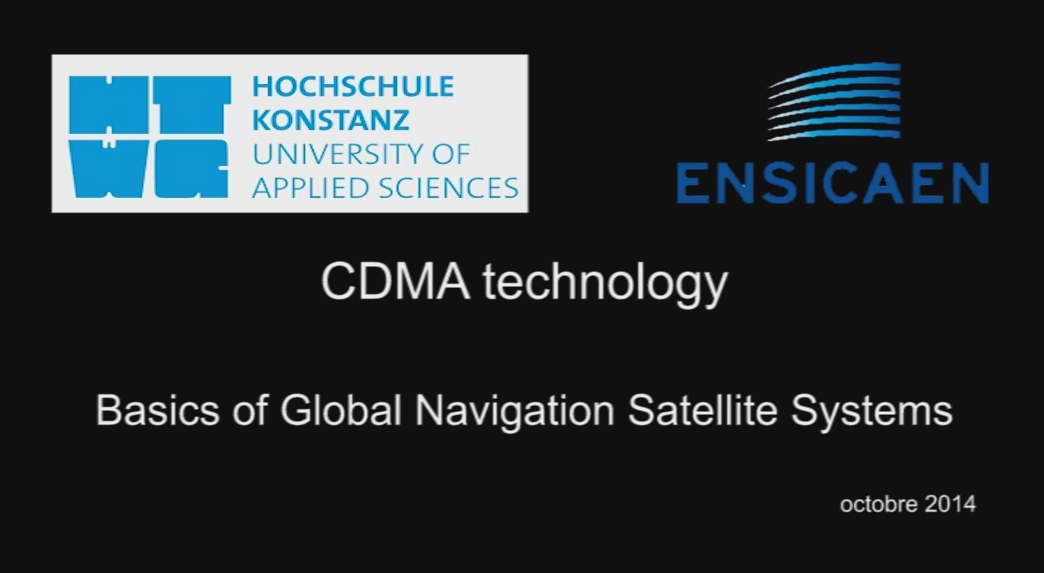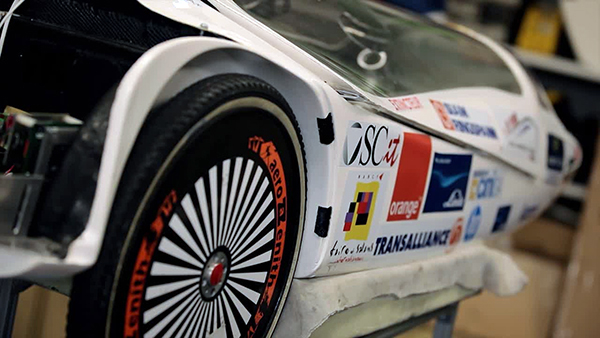Chapitres
Notice
04 - Advanced Spreading Codes (CDMA Technology)
- document 1 document 2 document 3
- niveau 1 niveau 2 niveau 3
Descriptif
Résumé :
Les communicationspar étalement de spectre constituent une réponse efficace aux problèmes detrajets multiples propres à la télécommunication mobile. Plus généralement, cetype de communications est particulièrement adapté aux communications à faiblerapport signal sur bruit. Parmi les différentes techniques d’étalement despectre, ce cours s’intéresse plus particulièrement à celle de l’étalement despectre par codage à l’aide de séquences pseudo-aléatoires, qualifié de codageCDMA pour ‘Code Division Multiple Access’. Cette technique a conduit à un grandnombre d’applications dans le domaine de la géolocalisation (système GPS ouGalileo), des télécommunications sans fils (UMTS WLAN, Bluetooth) mais aussidans le domaine des réseaux de capteurs.
Ce cours est lefruit d’une collaboration entre Prof. Wolfgang Skupin de l’HTWG Konstanz(University of Applied Sciences, Konstanz, Allemagne) et Prof. Stéphane Flamentde l’ENSICAEN (Grande Ecole, Caen, France).
Abstract :
Spread Spectrum Communications are very wellsuited to mobile communications where multipath propagation leads to strongfading. More generally, this kind of communication technique is well suited tolow signal to noise ratio communication channels. This lecture focuses on spread spectrumcommunications called ‘CDMA’, which stands for ‘Code Division Multiple Access’,where spreading is obtained by coding data with pseudo random binary sequence.CDMA technology is used in many applications such as geolocalisation (GPS,Gallileo), wireless communications (UMTS, WLAN, Bluetooth) or sensors network.
This lecture was designed together with Pr. W.Skupin from HTWG Konstanz (University of Applied Sciences, Konstanz, Germany)and Pr. S.Flament from ENSICAEN (‘GrandeEcole’, Caen, FRANCE).
Prof. Wolfgang Skupin
Pr. Skupin isProfessor at the University of Applied Sciences of Konstanz, HTWG (Germany) inthe field of Telecommunications. He isan expert in CDMA technology and was thus involved in the European GALILEOprogram aiming at providing a high-precision positioning system upon whichEuropean nations could rely independently from any other similar system likethe US GPS, the Russian GLOSNASS and the Chinese Compass.
Prof. Stéphane Flament
Pr. Flament is Professorat the National Graduate School of Engineering of Caen, ENSICAEN (France), inthe field of Electronics. His research domains deal with low noiseinstrumentation and applied physics of magnetic sensors and devices (https://www.greyc.fr/user/99).
Dans la même collection
-
00 - General Introduction to CDMA technology courses
SkupinWolfgangFlamentStéphaneRésumé : Les communications par étalement de spectre constituent une réponse efficace aux problèmes de trajets multiples propres à la télécommunication mobile. Plus généralement, ce type de
-
01 - Introduction to Spread Spectrum Communications (CDMA Technology)
SkupinWolfgangFlamentStéphaneRésumé : Les communications par étalement de spectre constituent une réponse efficace aux problèmes de trajets multiples propres à la télécommunication mobile. Plus généralement, ce type de
-
02 - CDMA/DS – Principle of Operation (CDMA Technology)
SkupinWolfgangFlamentStéphaneRésumé : Les communications par étalement de spectre constituent une réponse efficace aux problèmes de trajets multiples propres à la télécommunication mobile. Plus généralement, ce type de
-
05 - Principles of CDMA/DS Decoding (CDMA Technology)
SkupinWolfgangFlamentStéphaneRésumé : Les communications par étalement de spectre constituent une réponse efficace aux problèmes de trajets multiples propres à la télécommunication mobile. Plus généralement, ce type de
-
06 - Cellular Radio and System Capacity (CDMA Technology)
SkupinWolfgangFlamentStéphaneRésumé : Les communications par étalement de spectre constituent une réponse efficace aux problèmes de trajets multiples propres à la télécommunication mobile. Plus généralement, ce type de
-
07 - Basics of Global Navigation Satellite Systems (GNSS) (CDMA Technology)
SkupinWolfgangFlamentStéphaneRésumé : Les communications par étalement de spectre constituent une réponse efficace aux problèmes de trajets multiples propres à la télécommunication mobile. Plus généralement, ce type de
-
08 - Galileo : European GNSS (CDMA Technology)
SkupinWolfgangFlamentStéphaneRésumé : Les communications par étalement de spectre constituent une réponse efficace aux problèmes de trajets multiples propres à la télécommunication mobile. Plus généralement, ce type de
Avec les mêmes intervenants et intervenantes
-
00 - General Introduction to CDMA technology courses
SkupinWolfgangFlamentStéphaneRésumé : Les communications par étalement de spectre constituent une réponse efficace aux problèmes de trajets multiples propres à la télécommunication mobile. Plus généralement, ce type de
-
01 - Introduction to Spread Spectrum Communications (CDMA Technology)
SkupinWolfgangFlamentStéphaneRésumé : Les communications par étalement de spectre constituent une réponse efficace aux problèmes de trajets multiples propres à la télécommunication mobile. Plus généralement, ce type de
-
02 - CDMA/DS – Principle of Operation (CDMA Technology)
SkupinWolfgangFlamentStéphaneRésumé : Les communications par étalement de spectre constituent une réponse efficace aux problèmes de trajets multiples propres à la télécommunication mobile. Plus généralement, ce type de
-
05 - Principles of CDMA/DS Decoding (CDMA Technology)
SkupinWolfgangFlamentStéphaneRésumé : Les communications par étalement de spectre constituent une réponse efficace aux problèmes de trajets multiples propres à la télécommunication mobile. Plus généralement, ce type de
-
06 - Cellular Radio and System Capacity (CDMA Technology)
SkupinWolfgangFlamentStéphaneRésumé : Les communications par étalement de spectre constituent une réponse efficace aux problèmes de trajets multiples propres à la télécommunication mobile. Plus généralement, ce type de
-
07 - Basics of Global Navigation Satellite Systems (GNSS) (CDMA Technology)
SkupinWolfgangFlamentStéphaneRésumé : Les communications par étalement de spectre constituent une réponse efficace aux problèmes de trajets multiples propres à la télécommunication mobile. Plus généralement, ce type de
-
08 - Galileo : European GNSS (CDMA Technology)
SkupinWolfgangFlamentStéphaneRésumé : Les communications par étalement de spectre constituent une réponse efficace aux problèmes de trajets multiples propres à la télécommunication mobile. Plus généralement, ce type de
Sur le même thème
-
Discarded Digital : contrer l’obsolescence par les pratiques de réutilisation des rebuts du numériq…
NovaNicolasLe séminaire du CIS reçoit Nicolas Nova (Haute école d’art et de design, HEAD Genève) Discarded Digital : contrer l’obsolescence par les pratiques de réutilisation des rebuts du numérique
-
Nano-électronique et informatique
WeisbuchClaudeLes révolutions de l' information et des communications sont un des faits marquants du siècle et vont continuer à bouleverser dans ce nouveau siècle tous les domaines de l'activité humaine, y compris
-
Mécatronique et espace
Enregistré dans le cadre de Synoméca 2017, à Caen, au Dôme, le 7 avril 2017
-
Captil Pong Machine
Atelier "CAPTIL PONG machine" pendant le festival living labs au dôme en octobre 2016 dans le cadre de la fête de la science. Collégiens, lycéens et étudiant en BTS inventent un joystick pour un pong
-
Les systèmes de demain, autonomes et économes (ASR n°10 - CRAN)
Parmi les nombreuses recherches menées au Centre de Recherche en Automatique de Nancy, plusieurs visent à relever le défi de l'économie d'énergie. Pour l'une d'elles, en partenariat avec l'ESSTIN, le
-
00 - General Introduction to CDMA technology courses
SkupinWolfgangFlamentStéphaneRésumé : Les communications par étalement de spectre constituent une réponse efficace aux problèmes de trajets multiples propres à la télécommunication mobile. Plus généralement, ce type de
-
01 - Introduction to Spread Spectrum Communications (CDMA Technology)
SkupinWolfgangFlamentStéphaneRésumé : Les communications par étalement de spectre constituent une réponse efficace aux problèmes de trajets multiples propres à la télécommunication mobile. Plus généralement, ce type de
-
02 - CDMA/DS – Principle of Operation (CDMA Technology)
SkupinWolfgangFlamentStéphaneRésumé : Les communications par étalement de spectre constituent une réponse efficace aux problèmes de trajets multiples propres à la télécommunication mobile. Plus généralement, ce type de
-
05 - Principles of CDMA/DS Decoding (CDMA Technology)
SkupinWolfgangFlamentStéphaneRésumé : Les communications par étalement de spectre constituent une réponse efficace aux problèmes de trajets multiples propres à la télécommunication mobile. Plus généralement, ce type de
-
06 - Cellular Radio and System Capacity (CDMA Technology)
SkupinWolfgangFlamentStéphaneRésumé : Les communications par étalement de spectre constituent une réponse efficace aux problèmes de trajets multiples propres à la télécommunication mobile. Plus généralement, ce type de
-
07 - Basics of Global Navigation Satellite Systems (GNSS) (CDMA Technology)
SkupinWolfgangFlamentStéphaneRésumé : Les communications par étalement de spectre constituent une réponse efficace aux problèmes de trajets multiples propres à la télécommunication mobile. Plus généralement, ce type de
-
08 - Galileo : European GNSS (CDMA Technology)
SkupinWolfgangFlamentStéphaneRésumé : Les communications par étalement de spectre constituent une réponse efficace aux problèmes de trajets multiples propres à la télécommunication mobile. Plus généralement, ce type de












































